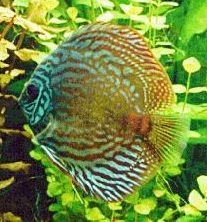

This site is dedicated to the king of the aquarium (Discus).
The discus was first described by Dr. Johnann Jacob Heckel of Vienna, Austria, in 1840. It wasn't until the early 1930's that the fish was seen and sold in the United States, under the popular name of pompadour fish. The fish being sold at the time was the brown discus, latter named Symphysodon Aequifasciata Axelrodi. William T. Innes described the discus it is of the pancake like. It a show fish. Its showy quality is increased as its size increases. It is interesting to note that at the time hobbyist thought it possible that the sexes could be told by the intensity of the fishes' color, the male being more colorful, also, that most of the fish being imported were females. For the most part attempts at breeding were unsuccessful. The problem started with poor water quality, improper temperature and lack of water changes. In general the fish had not been kept in optimum condition for spawning and were under lot of stress. Better shipping methods were developed and more discus began to appear in the trade market, still at a high prices. Soon breeders were starting to break the secrets of discus breeding. Also collectors in South America where learning how to capture and transport the fish in relatively good condition.
Today you will find discus with all sorts of names from,"Royal-Blue,"Hong Kong Blue,"Blue Face," discus which Jack Wattley states "is nothing more than a brown discus that has been treated with methyltestosterone". The "Candy-apple," is treated similarly and fed the eggs of the shrimp, Macrobrachium Rosenbergii, which adds the red/orange color to the facial area. The "Powder Blue" discus is really a "Royal Blue" discus with an overall powdery blue coloring and limited blue striation. Unfortunatly, according to Jack Wattely, this coloration only takes place in the males; the females look like regular brown discus. As for the famous "Wattley Turquoies" discus, both males and females will have the same coloration and both sexes will have bright red eyes.
Today buying discus is easier then ever before, but as alwasys it's "buyer beware". Buy only from reputable deealers. Buy the largest size discus babies you can afford. And buy in groups and let them pair off. Discus like company, clean water and space. Read about them before you buy. Here are Six Discus Book reviewed by Jerry Jellison.
Habitat
- In the wild cichlids live in slow moving or still waters where there are
plenty of hiding places, such as shores, heaps of rocks, or dense plant
growth. Cichlids are territorial and will regularly defend that territory,
especially when mating.

Description
- Body is flate pancake like, oval shape like. Dorsal and anal fin are not
very deep but have long bases. Ventral fins are elongated. Small mouth and large eyes.
Color is light or dark brown. Color is reddish brown. Has nine dark traverse lines,
most of which are visible. Pattern of fluorescent horizontal lines lie across the
entire body. Anal and dorsal fins have same color as body with a reddish edge. Ventral
fins are red and taper to a point.

General Care
- Requires a large, non-aggressive species tank with clumps of ribbon-leaved plants.
Requires both swimming space and hiding places. Depending on size of the tank, more
than one pair may be kept. Water temperature 28-32 C. Small live
animal matter will be eaten.

Diet
- Cichlids will generally eat anything. All kinds of live and dry food
will be accepted. Some household food accepted is lettuce, boiled spinach,
oatmeal and algae. Most cichlids will overeat if given the opportunity. With exception of discus. They will only eat live food such as brine shrimp, worm, or
beefheart.

Starting Gopher Site
- FINS
Here are some sites that might be of interest to you
FTP Sites
Newsgroups
- alt.qquaria
- rec.aquaria
- sci.aquaria
- rec.aquaria.freshwater.cichlids
Current Breeder's on the net:
- April's Healthy Hatcheries
- Bing Seto's Discus World
- Discus it!
- Discus Unlimited
- World Wide Fish Farm
The following has been added by the Electronic Desktop Project:
Please take a few minutes to send us your comments and suggestions. We read every message and try to respond promptly to questions. Your feedback will help us improve our project. Contact Us
Contact UsIf you are an educator who is using our NEXTSTEP or virtual applications in the classroom, we would especially like to hear from you. Let us know what you are doing and how it is working out. Continued support for this project will depend on its impact in science education.
If you are an educator who is interested in making use of our NEXTSTEP or virtual applications, please let us know how we can help.
Other Places To Go
 Return to the Electronic Desktop Project home page
Return to the Electronic Desktop Project home page Check out the WWW Virtual Application Catalog from the EDP
Check out the WWW Virtual Application Catalog from the EDP Check out the NEXTSTEP Application Catalog from the EDP
Check out the NEXTSTEP Application Catalog from the EDP Visit the home page for California State University, Los Angeles
Visit the home page for California State University, Los Angeles- FINS
 Bibliography
Bibliography